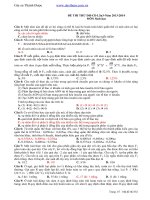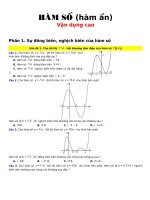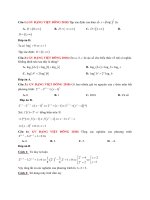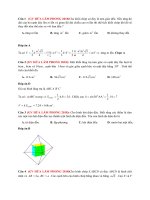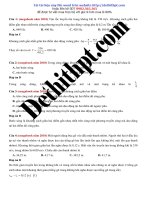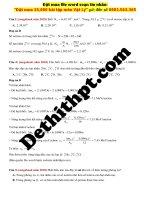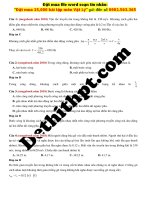Cs224W 2018 65
Bạn đang xem bản rút gọn của tài liệu. Xem và tải ngay bản đầy đủ của tài liệu tại đây (10.8 MB, 12 trang )
Encoding Visual Information using Node Embeddings
Varun Nambikrishnan
Stanford University
Karey Shi
Stanford Univeristy
Karan Singhal
Stanford University
Stanford, CA
Stanford, CA
Stanford, CA
Abstract
Node embedding techniques have been recently popularized for a variety of network analysis tasks, including
node classification, link prediction, and clustering. We
explore how well these methods perform on a graph containing Flickr interaction data, in which each node corresponds to an image, and images are linked by user interactions on the Flickr platform. Flickr images are a rich
medium, as their pixel data provides a benchmark to compare node embedding techniques against. Specifically, we
first explore how well node embedding techniques capture
image similarity without access to image pixels by comparing against state-of-the-art convolutional neural networks (CNNs). We then investigate the performance of
node embedding techniques in image classification, using features extracted from CNNs to produce a skyline.
Finally, we explore whether the information encoded in
the Flickr graph can augment CNN performance in image classification using RolX and feature concatenation.
the content of images can be modeled by the relational
metadata and information present in a network of images
in a social media context, such as those found on Flickr.
In such networks, relational metadata describes a variety
of interactions, such as which images were taken from the
same location, which images belong to a certain gallery
or group, which common tags are associated among images, and which images were captured by friends on the
sharing platform.
In this project, our contributions fall under five key research questions,
which
we believe are substantial and
novel enough to further the understanding of node embedding performance:
1. How much information about visual similarity
among images can we glean from relational interaction metadata using node embedding methods?
2. Using these embeddings,
can we perform well on
downstream tasks, such as image classification?
Our code can be found on Github [1].
3. How does performance on such tasks compare with
that of state-of-the-art CNN methods?
1. Introduction
4. Can we improve performance on these downstream
tasks by combining node embeddings with features
extracted from CNNs?
Currently, vast amounts of image information reside in
online photo sharing communities, such as Flickr, Pinterest, or Instagram, just to name
a few.
These expansive
and highly interactive communities maintain rich image
sharing networks with large amounts of metadata describing the nature of interactions within these social contexts.
With the existence of these modern data sources for images, the content and definition of these images on the
Web now extends beyond its visual collection of pixels
to incorporate the relational metadata present within its
social network.
While deep learning methods, such as convolutional
neural networks (CNNs), have soared in popularity due
to the efficacy of capturing image information through examining pixel data, we aim to explore the extent to which
5. Can other techniques that leverage relational data
(e.g. RolX) improve performance on these tasks?
By focusing on these questions, we build off of the intuition that the relationships discovered within the socialnetwork metadata likely parallels similarities in visual
content, and our project seeks to determine the extent
to which node embeddings generated from relational and
interaction metadata can represent and encompass useful
information about images.
In the process of exploring these five key questions,
we also explore a number of smaller research questions
along the way. For example, we use three different node
embedding methods in our work, providing insight into
how these methods compare at encoding visual and nonvisual information in the Flickr graph.
2. Related Work
There is previous work using the Flickr dataset by
McAuley and Leskovec which explores the use of socialnetwork metadata from online image-sharing platforms
for downstream
image
labeling tasks
[6].
These
tasks
include image label prediction, tag recomendation, and
group recommendation, and in this work, four datasets of
Flickr images and their corresponding metadata are used.
This work examines the performance of three different
models: an SVM using only low-level image features, an
SVM containing low-level features and metadata features
modeled independently, and a graphical model leveraging the relational metadata. The authors found that the
graphical model outperforms methods that utilize only
image-content-based features, and certain relational fea-
tures (e.g. shared membership to a gallery, shared
tion) prove to be strong predictors for the considered
sification tasks. This work was published before
node embedding techniques were developed and
SVMs
were considered
locaclassome
when
state of the art, and our aim is
to validate whether newer graph techniques have the capacity to perform well against newer image classification
methods, such as CNNs. Even if graphical models do not
prove to be optimal anymore, there is still much to be explored in terms of the extent of information that they can
capture about an image without utilizing the per pixel information that the image itself contains. It is also likely
that node embeddings capture structural information orthogonal from the information stored in visual features,
which can improve performance in downstream tasks in
tandem with visual features.
Other works, such as those by Hamilton et al. and
Goyal et al., have reviewed various node embedding techniques, and from their characterizations of these diverse
techniques, we can examine the respective strengths and
advantages of each approach [9][8]. These papers separate the space of node embedding approaches into three
general categories: matrix factorization, random walk,
and deep learning based methods.
In matrix factorization methods, information from the
graph is recorded in a matrix, which is then factorized to
produce embeddings. These methods involve a deterministic measure of node similarity, including inner-product
methods, where the strength of the relationship between
2 nodes is proportional to the dot product of their embeddings. These inner-product methods include Graph Factorization (GF), GraRep, and HOPE.
Random walk methods define node similarity in a more
flexible and stochastic manner, and such approaches include DeepWalk and node2vec. These shallow embedding approaches also use a decoder based on inner products, but instead of decoding a deterministic node similarity measure as done by the matrix factorization approaches, these methods optimize embeddings to encode
the statistics of random walks.
Deep learning based approaches are diverse, but deep
autoencoders have been used for dimensionality reductionthese approaches utilize auto encoder methods to synthesize information about a node’s neighborhood. Examples of deep learning based node embedding approaches
include Deep Neural Graph Representations (DNGR) and
Structural Deep Network Embeddings (SDNE).
We also explore whether other techniques that leverage relational graph information can lead to better performance on a downstream task such as image classification.
We
explore one such method,
RolX
(Role eXtraction),
which is an unsupervised method proposed by Henderson
et. al to extract structural roles from networks by recursively expanding features of a node using the features of
its neighbors [5]. While the node embedding techniques
already take advantage of the graph’s structure, we believe that RolX could improve the performance of CNN
embeddings, as they don’t naturally leverage relational
data as node2vec and SDNE do.
3. Dataset and Graph Representation
We use the dataset of Flickr image relationships built
by McAuley and Leskovec [6]. This dataset was aggregated from four popular datasets of images with human
annotated groundtruth,
and the image
nodes have been
augmented with social network metadata collected from
Flickr. These four sources are the PASCAL Visual Object
Challenge (PASCAL), the MIR Flickr Retrieval Evaluation (MIR), the ImageCLEF Annotation Task (CLEP),
and the NUS Web Image Dataset (NUS) [3].
In addition to utilizing the entire cumulative dataset
of image metadata from these four datasets (which, after filtering on amount of substantial metadata available,
contains 105,938 images), we have decided to further focus on the NUS dataset, which, in its entirety, consists of
269,642 images, where Flickr sources are available for
all images. We have acquired the raw image data for
the NUS dataset, which was used for implementing our
visual-content based CNN approach (of the 105,938 images for which we have complete metadata information,
we have images for 89,251)
[3].
For all the Flickr im-
ages in our dataset, the original metadata collected for
each photo includes the photo title, description, loca-
tion, timestamp,
viewcount,
upload date; user informa-
tion, photo tags, and the groups/collections/galleries that
the image belongs to; and comment threads associated
with each photo.
The metadata is aggregated as node and edge features
of a network representing the collection of images available. Each node represents an image, and each edge represents a relationship between two images, where an edge
is drawn if any of the edge features are non-zero. Node
features include the properties of the image, including
the groups or categories that the image belongs to in its
respective dataset. Edge features include seven properties as listed by McAuley and Leskovec: the number of
common tags/groups/collections/galleries, and indicators
for whether both photos were taken in the same location,
taken by the same user, and taken by mutual contacts or
friends. To get a better context of the size of the graph,
for the entire curated Flickr image dataset where informa-
tion of all pieces of metdata is available, we have a resulting 105,938 nodes (the number of images), and 2,316,948
edges. For the induced subgraph on our NUS images (for
which we have pixel data), there are 89,251 nodes.
We also created other induced subgraphs to create image classification tasks from the larger dataset. We use
these image classification tasks to measure how useful
node embeddings are for image classification, both alone
and in tandem with CNN features. We detail these induced subgraphs in Section 4.4.
4. Methods
At a high level, our approach involves computing image embeddings using both node embeddings on the
Flickr images graph and CNN embeddings trained on the
images themselves. We explore three node embedding
techniques to serve as our exploration of graphical models, and we use CNNs to serve as a skyline for performance in downstream tasks, such as image classification.
As an initial metric of evaluation for the quality of our
embeddings, we use the cosine distances between images
to establish a notion about the similarity of different embeddings (we discuss our method for doing so below).
This metric allows us to determine how well node embeddings capture the visual similarity encoded by CNN image features, and it allows us to compare the relationships
among our various node embedding techniques. We then
use our produced embeddings for an image classification
downstream task, to better understand how performance
compares for embeddings that capture different types of
information about the images.
4.1. Node Embedding Techniques
We define a node embedding on a graph G = (V, E) as
defined in Goyal, namely a mapping
firvivy
c1”, Vị € [n]
such that d <
|V| and the function f preserves some
proximity measure defined on graph G [6]. Essentially,
we are trying to map each node to a low-dimensional feature vector while still preserving the connections between
vertices.
For our experiments,
we chose d
=
128,
as
it is a common choice in the literature. We choose one
embedding technique from each of the three high-level
categories described in Section 2: HOPE, node2vec, and
SDNE.
4.1.1
HOPE embeddings
The first node embedding method we examine is Higher
Order Proximity preserved Embeddings, or HOPE [7].
HOPE is a factorization based method, which represents
the graph as a matrix and then uses some form of factorization to generate the embeddings. The objective function HOPE aims to compute:
min |8 — Y;Y/ |lš
where S is the similarity matrix of the graph and Y,, Y;
are the source and target node embeddings. Different
similarity measures can be used, including Katz Index,
Rooted Page Rank, Common Neighbors, and Adamic-
Adar score. For our experiments we chose the Katz Index, which is a weighted summation over the path set of
two vertices. We must also choose a decay parameter, (,
which determines how fast the weight of a path decays as
the length of path grows. For our experiments, we chose
B=.01.
4.1.2
node2vec embeddings
Our second node embedding method is node2vec, a biased random walk procedure that uses a flexible notion of
neighborhood that balances capturing a node’s community and its structural role in the network [2]. We seek to
maximize the following objective, which is based off of
the skip-gram architecture in word2vec:
maxÐ ` log(P(N;(u)|ƒ(4)))
u€V
This objective maximizes the log probability of observ-
ing a network neighborhood N,(u) for a node u (gener-
ated by the sampling strategy s), conditioned on the feature representation f of that node. We control the sam-
pling strategy using an in-out parameter g, which controls how biased the search is towards “inward” nodes
vs. “outward” nodes in generating neighborhoods. These
searches model BFS and DFS, respectively, and adjusting
q allows us to interpolate between the two search strategies, providing us the aforementioned flexible notion of
node neighborhoods. We also have a return parameter p
that controls the likelihood of returning to a node immediately after visiting it in a walk. Setting this high encourages more exploration (no 2-hop redundancy) while
setting it low keeps the walk close to the original node.
Using random walks allows node2vec to be much more
time/space efficient than a pure BFS/DFS strategy. For
our experiments, we chose the number of walks per node
u to be 10, the length of each walk to be 80, the return
parameter p to be 1, and the in-out parameter q to be 5.
our experiments we used a 3 hidden layer autoencoder,
and otherwise chose the standard parameters in the implementation provided by GEM and in Goyal et al. [8].
4.2. Convolutional Neural Network Embeddings
To provide a benchmark set of embeddings that capture visual information about images extremely well, we
rely on convolutional neural networks (CNNs), which
have risen to great popularity within the computer vision
community for classifying images. CNNs have achieved
extremely high accuracy on diverse image classification
tasks, outperforming humans in some cases. Because
CNNs progressively process information in images from
low-level features to high-level features before making
a final classification decision, we can extract the highlevel features from the output of second to last layer of
the CNN,
4.1.3
SDNE embeddings
The last embedding method we explore is Structural
Deep Network Embedding or SDNE [10]. This is a deep
learning based method that uses autoencoders to reduce
dimensionality, as they have the ability to model highly
non-linear structure in graphs. SDNE tries to preserve
both first and second order proximities, where first order
proximity is the pairwise proximity between nodes, and
second order proximity is the proximity of two nodes’
neighborhoods.
SDNE consists two parts: an unsupervised component that reconstructs the neighborhood
structure of each vertex, to preserve second order proxim-
ity, and a supervised component that uses the first-order
proximity to restrict and refine the autoencoders’ representation in latent space. We seek to jointly minimize
these proximities with the following objective function:
a
=
Lind
+ Lipps
+
a
We have that £onq is the autoencoder loss function, mini-
mizing the reconstruction of the nodes from their embeddings:
Lona = |(X — X) © Bl
B is used to more heavily penalize the reconstruction
error of non-zero elements, to get the autoencoder to
avoid reconstructing only zero elements. L£,,,; penalizes
similar vertexes that are mapped far away in the embedding space:
n
List =) sigllye — will
i,j=l
Where s;7 is the similarity score between nodes 7 and
j, aS mentioned in the HOPE embedding section. For
i.e.
the layer before the classification (fully-
connected with softmax) layer. By passing each image
through our CNNs, we can use the output of this secondto-last layer as a visual encoding of an image. These features are useful to serve as a skyline for performance on
downstream tasks, as they encode the most information
about the actual visual content of an image.
We use two of the ResNet architectures to produce visual features, ResNet-50 and ResNet-18 [4]. ResNets can
be incredibly deep neural network architectures, with skip
connections interleaved throughout the depth of the network to provide a fast-forwarded channel for information
to pass down to later layers, which overcomes some dis-
advantages with extremely deep networks. These models
are very popular in the computer vision community, and
currently produce near state-of-the-art performance in
image classification for the ImageNet dataset. We extract
visual features by running Flickr images forward through
the networks, extracting activations immediately before
the fully-connected classification layer.
Note that no
training or fine-tuning of these networks on our datasets
was done. For ResNet-18, this produces embeddings with
dimensionality 512, and for ResNet-50, this produces em-
beddings with dimensionality 2048.
To produce the embeddings for the 89k images for
which we had both pixel data and coverage in the dataset
provided by McAuley and Leskovec on such deep networks, we set up a GPU instance on Google Cloud
Platform,
using an NVIDIA
K80
GPU.
Before sending
images through the networks, we rescaled them to be
224x224 and normalized the mean and standard deviation
of pixel values according to the mean and standard deviation of the pixel values described in the original paper.
While the paper describes creating multiple crops and using other augmentation techniques (along with ensemble
techniques), we do not do this.
4.3. Embedding Similarity
A key element of our approach 1s a technique to better understand how similar different sets of image embeddings are, which works across embedding techniques
(which may embed nodes into different spaces) and even
different dimensionalities of embeddings. The high-level
idea is to take two different embeddings of the same set
of nodes and treat them as models for determining “distance” between nodes. If we sample two nodes and ask
the two models to make a prediction about how distant the
nodes are, if the models make similar (correlated) predic-
tions over many samples, then the models have a similar
notion of node similarity, and the embeddings
are simi-
lar. We can compute correlations using the Pearson correlation (to capture linear relationships between the similarities predicted by our models) and the Spearman (or
rank) correlation (to capture non-linear relationships). We
can also plot predicted distances with one embedding approach versus another, to produce a visual indicating how
closely related model predictions are. With this high-level
intuition, we present the full algorithm in Algorithm 1.
Data: 2 sets of embeddings for a shared group of
nodes (emb1, emb2), number of samples
Result: A plot of predicted distances, Pearson and
Spearman correlations
X=[l.Y=Ï]:
for i in range(num_samples) do
left, right = random.sample(nodes, 2);
dist1 = cosine_dist(emb1 (left), emb1(right));
dist2 = cosine_dist(emb2(left), emb2(right));
X.append(dist1);
Y.append(dist2);
end
plot(X, Y);
p_r = pearson(X, Y);
S_r = spearman(X, Y);
Algorithm 1: Computing embedding similarity for two
embeddings for a shared set of nodes.
Note that our use of the Spearman correlation does not
suffer from instability issues related to having repeated
elements, as it is unlikely that the same exact pair of ele-
ments is sampled twice.
4.4. Image Classification
Given image embeddings produced from either node
embedding techniques or CNNs, a feedforward neural
network (or other techniques) can be used to predict
classes for different images. Image classification is an
interesting task in this context because it is not necessarily clear that embeddings that capture visual information
the best will necessarily perform best at image classification (McAuley and Leskovec found that graphical methods performed better in some cases than simple visual
methods).
Though we expect CNN features to perform better than
the node embeddings we produce (because they have
been highly optimized for image classification and pixels
are a rich source of visual information), we suspect that
the unique metadata that will likely be encoded in node
embeddings will have some value, and it will be interest-
ing to see how performance compares, especially across
different subsets of the graph (do we do better where the
graph is more dense, as in the “popular” subgraph described above?). Another interesting question to explore
is whether we can achieve better performance by concatenating visual and graphical features.
To set up these image classification tasks, we first establish the exact classes of images,
collect the relevant
images for that task, induce a subgraph on those images,
generate node embeddings using this subgraph, and train
and test each of our node embeddings and ResNet embeddings using a neural network. The NUS dataset contains 81 labels in total,
and each image
in the dataset
can be associated with one or more labels. We examine
the distribution of the labels across the dataset and find
that the labels are not close to being uniformly distributed
across images, with multiple labels referring to overlapping concepts. Images can have up to 13 labels, and the
most frequent label (‘sky’) contains 74190 images while
the least frequent label (‘map’) contains only 60 images.
We ultimately decide to construct classes by hand according to reasonable higher-level categories, aggregating together subcategories if necessary, and we evaluate performance across several image classification tasks with
varying number of classes.
Our initial classification task is with 2 classes: ‘person’ and ‘animal.’ (Note: the ‘animal’ class is aggregated
across multiple categories to help correct class imbalance,
such as ‘birds,
“dog,
‘horses,
and
‘cow’).
We
assign
images a label of ‘person’ if it belongs to the ‘person’
category and not to any ‘animal’ subcategory. We assign
images a label of ‘animal’ if it belongs to at least one ‘animal’ subcategory and not to any ‘person’ category. The
induced subgraph has 32899 unique nodes (18948 person
images and 13951 animal images) with 75742 edges.
We set up 2 other classification tasks with more classes
involved for more opportunities of comparison, and especially to provide the ResNet with a more difficult task
to see if our methods can supplement performance (it already achieves nearly perfect accuracy on a simple 2-class
classification task).
We construct a task with 3 classes:
‘person,’ ‘animal,’ ‘plant.’ The ‘plant’ class is aggregated
in the same manner as the ‘animal’ class, and includes
subcategories such as ‘flowers,’ ‘tree,’ and ‘leaf.’ This
induced subgraph includes 42174 unique nodes (19720,
13277, 9177 images of category “person, ‘animal,’ and
‘plant,’ respectively) with 112229 edges. We also construct a task with 5 classes:
“person,
‘animal,’
‘plant,
‘building, and ‘scenery.
The induced graph on images from these five classes has 26474 unique nodes with
97206 edges.
In addition to evaluating the performance of our node
embeddings
(HOPE,
node2vec,
SDNE)
on these down-
stream tasks against our skyline performance with CNN
embeddings, we also evaluate performance using augmented embeddings, namely CNN embeddings concatenated with node embeddings, and node embeddings con-
catenated with each other. We also examine the performance of incorporating relational information with our
CNN embeddings through other techniques such as RolX,
described in section 4.5.
4.5. Augmenting Embeddings with RolX
While embeddings are one way of utilizing graph structure, there are many other techniques to take advantage of
relational data. One of these methods is RolX, which uses
recursive feature extraction for a specified number of iterations to improve the initial feature representations of
node [5]. In our case, the initial feature representation is
simply the embedding for that node according to our node
embedding techniques or CNNs. On each iteration, we iterate through each node and extend its embedding with
the mean embedding of all its neighbors. We ran this
for 1 and 2 iterations on all three node embeddings and
the CNN embeddings. Since the size of the embeddings
increases exponentially with the number of embeddings,
doing RolX for more than a few iterations is unfeasible.
5. Results and Analysis
5.1. Hyperparameter Tuning
We performed grid search across the possible hyperparameters for each node embedding method, evaluating
based on how similar each embedding was to the CNN
embedding. Our intuition is that the ideal node embedding is able to capture the most visual information, for
which the CNN embeddings serves as the skyline. For
node2vec, we found that gq = .01, p = 1 produced
the highest correlation with the CNN embeddings, which
aligns with random walks using a DFS-approach. This
aligns with the intuition that images that are visually similar to one another would exhibit strong homophily-based
relationships, and thus a macroscopic understanding of
the network would be necessary to capture this organi-
ResNet-18
HOPE
node2vec
SDNE
1.000
0.007
0.051
0.046
ResNet-18 |
1.000
0.437
1.000
0.383
0.709
1.000
HOPE | node2vec | SDNE
Table 1: Spearman correlation scores of cosine distances
measured across various embedding methods.
zation. For SDNE, we found that choosing B = 5 produced the highest correlation, and for HOPE we found
that 3 = 1 produced the highest correlation.
5.2. Encoding Visual Similarity
Our first key task was examining the extent to which
we can capture information about visual similarity using
our various node embedding methods, which utilize only
relational interaction metadata. We compute four sets of
embeddings, one for each of the node embedding techniques we examine: CNN (our skyline, using ResNet-18),
HOPE, node2vec, and SDNE. We sample 10,000 pairs of
nodes of our popular subgraph, which consists of nodes
with particularly high degree, and for each set of embeddings, we compute the cosine distance between each corresponding pair of node embeddings. This gives us four
sets of cosine distances, and we evaluate both the Pearson
and Spearman correlation scores for each pair of embedding method. Our Spearman correlation scores are reported in Table 1.
It is somewhat surprising to find that each of our node
embedding techniques captures information that is mostly
orthogonal to the information encoded by our CNN embeddings. This can be seen from the relatively low correlation scores between ResNet and the node embeddings.
This suggests that the content gleaned from the relational
data by HOPE,
node2vec,
and SDNE
could be used to
supplement ResNet in downstream tasks. Despite this
lack of correlation with the visual features encoded by
the CNN embeddings, the cosine-distances among node
embeddings seem to be more highly correlated. This is
reasonable to expect given that they are all encoding relational information, while the CNN embeddings are encoding an entirely different type of information (per-pixel
visual information). Plots of some of the sampled similarities between embeddings on one of our subgraphs are
contained in the Appendix.
5.3. Image Classification
After computing embedding similarity, we evaluate our
node embeddings using our downstream task: image classification. From our examination of each embedding’s capacity to encode visual similarity, we found that node2vec
ResNet-18 | node2vec | SDNE | HOPE
2-class | 97.26
3-class | 94.81
5-class | 89.54
76.84
67.71
59.29
Person-Animal Resnet18 t-SNE Projection
73.10 | 73.40
56.83 | —
47.21 | —
404
Person
Animal
«+
Free
1, Sette ZA RES
*
20 3
Table 2: Accuracies for image classification tasks across
CNN and the three node embeddings.
* Siete
wate
eet
z
`
2ˆ“
ak
a cee “ho
GEN
`.
ded
SAE
¢
fee
ug
ort
had a higher correlation with the CNN embeddings than
the other methods.
As such, we chose focus more heav-
ily on node2vec on our evaluation on downstream image
classification, as it would provide the closest performance
in comparison to the skyline of our CNN.
We use a simple Multi-layer Perceptron classifier to
perform the downstream image classification tasks described in section 4.4. Our network consists of one hidden layer of 100 nodes with a ReLU activation. We use
the Adam solver for optimization, and also use early stopping using a validation set 10% of the size of the training
set. The classifier takes in image and node embeddings
as input and outputs probabilities (using a softmax final
layer) for the desired classes.
Figure 1: TSNE plot for ResNet-18
person-animal subgraph.
60
+
40
+
Standard Embeddings
Our results for the 2, 3, and 5-class image classification
task can be found in table 2. We did not create node embeddings using HOPE for the 3-class and 5-class tasks
because the induced subgraph was too large to compute.
We note that node2vec achieves the highest performance
out of the three node embedding techniques. It is also
interesting to see that SDNE performance drops significantly as the classification task becomes more complex.
5.3.2
Analysis of Encoded Information
To further inspect how the node embedding techniques
are using relational data to encode information about the
images, we used t-SNE dimensionality reduction on our
embeddings and plotted our embeddings for the 2-class
classification task in 2D space. In Figure 1, we have the
plot for the ResNet-18 embeddings on this subgraph, and
in Figure 2, we have the plot for the node2vec embeddings. We can see that the ResNet-18 embeddings creates
distinct clusters between the two image classes, whereas
the node2vec embedding does not do as well, although
there is still some separation between classes. This indicates that it is unlikely that changing our image classification technique (e.g. tuning hyperparameters) is unlikely
to improve results significantly for the node2vec embedding.
on
Person-Animal Node2Vec q=0.01 t-SNE Projection
..
>
-
.
=
.
ali 20
*
~..
ae
đ
mỡ
+.
u
*
om,
SPR
ae
oe?
ơ
b2
Oe
ee
2
.
Te
tỏ,
Fe
s
Q9
T
9
,9%s
vn 8 nhi
Be
wg
ta
iqXe P38
`.
+.
eS
BASE
2%.
e 3
CN Ta
ef wees
3
Oe? 2 ĂẰ9 1L 6 SỐ
š
“
s
*
—
°
roe
°
a
Sẻ
c*
*
Pat
CHẾ
4X
.
o
°
.-
Animal
*
eo
veHE TK th(2Á
so95
Tổ
- off te
hs
tue
k
°
.®
ce
kì
$
..
`
cs
Š
.
“Syn
*
`
ˆ
a.
a
:
°`%
h”e
4
—60
—40
~20
0
20
Figure 2: TSNE plot for node2vec
person-animal subgraph.
5.3.3
es
Đ do
°
Person
+
S22 9S
in * su
+
-
+
5
_..o
PoreHEB ols
..
—60
s
ly”
Nà
NTpte
Bat
Pes
tí
“+f
8
steve
vn VƠ2°
is
te
—40
Š
sẽ:
SÁ9S e9 S2ŸS 2
2323245 83 he
a
_
0
Š
°
¬=
2
5.3.1
embeddings
40
60
embeddings
on
Concatenated Embeddings
We then examine whether concatenating different embeddings together can help boost performance on these
downstream tasks. We found positive results when concatenating the ResNet embeddings with the node2vec embeddings, which show that the added relational informa-
tion encoded by the node2vec embeddings can help performance on these downstream tasks as opposed to features solely derived from visual information. Our results
for concatenation improvement can be found in Table 3
5.3.4
Embeddings with RolX
We also inspect the effects of applying the RolX on the
CNN embeddings. We believe that this would provide
ResNet-18 | ResNet-18 + node2vec
2-class | 97.26
97.33
3-class | 94.81
95.07
5-class | 89.54
89.43
node2vec
80
sự
Table 3: Comparison of accuracies for image classification tasks between ResNet-18 embeddings and ResNet18 embeddings concatenated with node2vec embeddings.
ResNet-18
node2vec with RolX (2 iterations)
5
76.8
71.4
70
65
617
68-5
60
59.3 | 04
55
ResNet-18 with RolX (1 iteration)
2-class
3-class
5-class
100
99
Figure 4:
Accuracies
for 2, 3, 5-class tasks, highlight-
98
ing the accuracy boost with embeddings
7
node2vec with Rolx for 2 iterations.
g2
%
lo
95
94
94.8
94.9
:
93
2-class
3-class
produced by
tering coefficient, and thus were not optimal for running
node embedding techniques. As such we ran experiments
filtering which nodes we run classification on, by their
node degree, to measure how well the node embeddings
Figure 3: Accuracies for 2-class and 3-class tasks, highlighting the accuracy boost with embeddings produced by
ResNet-18 with Rolx for | iteration.
do as the information they have for a node increases. We
see in Figure 5 that node2vec steadily produces a better classification accuracy as the degree of the node increases, while ResNet’s accuracy does not improve with
another way to incorporate relational information while
still taking advantage of the rich visual information encoded by the CNN embeddings. We perform RolX on the
respective subgraphs induced for the first 2 tasks (2-class
and 3-class), and our results are shown in Figure 3. We
find that for the 2-class classification task, we were able
to reduce the classification error by 10% with embeddings
produced by ResNet-18 with RolX used for 1 iteration.
We additionally apply RolX to our node2vec embeddings to see if we can observe a similar boost in performance on these downstream tasks. In Figure 4, we can see
that upon applying RolX for 2 iterations, we can achieve
a nontrivial increase in performance. We did not observe
as much of an increase with utilizing only 1 iteration of
RolX.
5.4. Analysis of Graph Quality
The original Flickr graph was very large, which meant
that it would take an extremely long time to run/tune
our embeddings.
Additionally, the labels were quite
poor (lots of misclassified examples/ambigous classifications).
To solve this issue, we chose to create 2,3, and
5-class subgraphs
embeddings.
(with better labels) to run our node
However,
this meant that we lost a lot of
nodes/edges, meaning there was much less network structure from the node embeddings to learn from. These
subgraphs were quite sparse, with very low average clus-
degree. This is promising, as it shows us that node2vec’s
performance scales well with the amount of information it
can utilize. We also see in Figure 6, that concatenating the
node2vec embedding with the ResNet embedding provides an increase over the ResNet embedding alone in the
same experimental setup. This shows us that node2vec
is capturing additional, relevant information for the image classification task, and shows us that relational infor-
mation can complement visual information in these types
of tasks. Lastly, we see in Figure 7 that concatenating
SDNE and node2vec embeddings also provides an increase in accuracy, showing that the different methods of
node embeddings are capturing slightly different content
even though they are both trained on the same graph. In
general, we see that concatenation leads to improvement,
especially in sparse graphs, where we need to capture almost all the information provided to get a satisfactory embedding.
6. Conclusion and Future Work
Unsurprisingly, we find that CNN embeddings perform
better than the node embeddings at encoding visual information, as CNNs
are optimized for understanding the
visual content of images. We also note that the node embeddings seem to capture different content than the CNN
embeddings, as the correlation between the two types of
embeddings is also quite low.
However,
we see that the
Classification Results on Person-Animal-Plant Subgraphs
aS
eee
eee
4
0.70__
0.85 31
0.65 31
Score
0.90 4
Accuracy
Accuracy Score
B5
0.80 4
0.75 4
2.0
25
3.0
25
Minimum
——
ResNet-18
——
Node2Vec
4.0
4.5
5.0
Node Degree
0.60 4
0.50 4
Node2Vec
SDNE
——
Node2Vec
+ SDNE
RE
2.0
25
3.0
Minimum
Figure 5: Improvement in performance for node2vec embeddings upon using a subset of nodes with higher degree
to train and evaluate our classifier. Note that classification
score stays relatively constant for our ResNet-18 embeddings.
i
—
——
0.55 4
0:10
Classification Results on Person-Animal-Plant Subgraphs
—
ResNet-18
——
Node2Vec
+ ResNet-18
0.98 4
Accuracy Score
Classification Results on Person-Animal-Plant Subgraphs
0.75 4
3.5
4.0
4.5
5.0
Node Degree
Figure 7: Improvement in performance
ing node2vec and SDNE upon using
degree nodes. Note that SDNE alone
in performance, but concatenation of
does improve.
when concatenatsubset of higherdoes not improve
the 2 embeddings
recognition task. This shows that even on relatively simple image classification tasks, relational data can be helpful in addition to the raw pixels. This point is advanced by
the fact that using RolX embeddings improves accuracy
over using plain embeddings.
We also notice that node2vec and SDNE differed quite
dramatically in their classification, especially as the number of classes increases. SDNE fares significantly worse;
0.94 4
however this is somewhat expected, as similar differences
0.92 4
0.90
2.0
25
3.0
3.5
Minimum
4.0
4.5
5.0
Node Degree
Figure 6: Improvement in performance for concatenated
embeddings (ResNet-18 with node2vec) upon using subset of higher-degree nodes.
different types of node embeddings are well correlated
with each other, which makes sense as they are synthesizing the same relational data. We also see that even though
the content captured by node2vec is almost orthogonal to
the CNN
embeddings,
we note that it performs reason-
ably well on our downstream image classification task,
which indicates that it is capturing content useful for image classification, even though it may not be visual information. We also see that concatenating the node2vec
embeddings with the CNN embeddings provides a small
boost in classification accuracy, meaning the the information the node2vec embedding is relevant to our image
on the task of node classification in Goyal et. al’s paper
as well. It seems that the random walk approach may be
better suited for classification tasks, while deep learning
approaches such as SDNE are better for tasks such as link
prediction. Training SDNE on a GPU may help bridge
this gap.
We also found that the subgraphs from the original Flickr graph we created were quite sparse, as the
edge:node ratio was usually between 2:1 and 4:1. This
adversely impacted our node embeddings as it meant
there was much less network structure than expected. We
verified this by comparing the classification accuracy of
the highest degree nodes (the nodes with the most graph
structure to leverage) to the classification of lower degree
nodes, and found that higher degree nodes had a much
better classification accuracy. Thus, we believe that in a
denser network, the node embedding methods would pro-
duce a more significant impact.
In future work, we would like to explore how node
embeddings function on other image graphs, especially
denser ones where the graph structure can be better uti-
lized. Additionally, experimenting with other ways to
classify nodes in a graph, such as iterative classification
or loopy belief propagation, or a mixture of these methods could prove useful in image-related graphs. It would
also be interesting to examine different ways to incorporate more nuanced information about the relationships between images to better inform our embeddings. We would
also want to find more challenging classification tasks in
which a ResNet would not be fully successful with, in
which case adding relational data would be more significantly helpfulFurthermore, a survey paper on these types
of experiments could help clarify in which situations certain classification methods are the most effective, which
could be quite useful to the research community.
References
[1]
Project
source code.
/>karan1149/cs224w-pro
Ject.
[2]
J. L. A. Grover.
networks.
[3|
T.-S.
node2vec:
Scalable feature learning for
2016.
Chua,
J. Tang,
R. Hong,
H. Li, Z. Luo,
and Y.-
T. Zheng. Nus-wide: A real-world web image database
from national university of singapore. In Proc. of ACM
Conf. on Image and Video Retrieval (CIVR’09), Santorini,
Greece., July 8-10, 2009.
[4]
K. He, X. Zhang, S. Ren, and J. Sun. Deep residual learn-
ing for image recognition. CoRR, abs/1512.03385, 2015.
[5]
K.
Henderson,
B.
Gallagher,
T. Eliassi-Rad,
H. Tong,
S. Basu, L. Akoglu, D. Koutra, C. Faloutsos, and L. Li.
Rolkx: structural role extraction & mining in large graphs.
In Proceedings of the 18th ACM SIGKDD international
conference on Knowledge discovery and data mining,
pages 1231-1239. ACM, 2012.
[6] J. McAuley and J. Leskovec. Image labeling on a network: Using social-network metadata for image classification. 2012.
[7]
M. Ou, P. Cui, J. Pei, Z. Zhang, and W. Zhu. Asymmetric
transitivity preserving graph embedding. In Proceedings
of the 22nd ACM SIGKDD international conference on
Knowledge discovery and data mining, pages 1105-1114.
ACM, 2016.
[8] E. F. P. Goyal.
Graph embedding techniques, applica-
tions, and performance: A survey. 2017.
[9] J. L. W. Hamilton, R. Ying. Representation learning on
graphs: Methods and applications. 2018.
[10]
D. Wang,
P. Cui, and W. Zhu.
Structural deep network
embedding. In Proceedings of the 22nd ACM SIGKDD
international conference on Knowledge discovery and
data mining, pages 1225-1234. ACM, 2016.
7. Appendix: Embedding Similarity Plots
Distances of Resnet18 Embeddings vs. Sdne Popular Subgraph
6 os 3
7.1. Comparison with ResNet-18
Hogi
8
š
The following graphs show the relationships between
predicted image distances according to different embeddings, as well as the corresponding Pearson and Spear-
man correlations.
cv
:
5
2
ee
Ề
Pearson = 0.068
<<"
Spearman = 0.046
0.6 4
é
B oa
2
5
ø 023
0.0 +
oe
0.2
0.3
0.4
0.5
0.6
Distance according to Resnet18 Embeddings
0.7
7.2. Comparison between Node Embedding Methods
7.1.1.
Node Embeddings on Popular Subgraph
7.2.1
Distances of Resnet18 Embeddings vs. Hope Popular Subgraph
1.04
=
oo oe oy
compe
ee
a
os
3
h
8
2
by
Node Embeddings on Popular Subgraph
Distances of Node2Vec Popular Subgraph vs. Hope Popular Subgraph
«
1.0 4
a
8
ao
Do
2
a 0.8 +
3 08 J
-
-
85
85
2@ 0-6 4
2@ 0-6 4
=
=
a
a
Qa
oS
Qa
S
9
> 0.44
9
> 0.44
5
2°
8
@ 0.24
8
@ 0.24
°
uv
0.04
‘
Pearson = 0.012...
Spearman =0.007.:
0.2
0.3
Đ
c
£
7
on
*X$ s.z:
0.4
0.5
0.6
ate
0.8 4
Bề si
Pearson
00,
0.7
Distance according to Resnet18 Embeddings
Distances of Resnet18 Embeddings vs. Node2Vec Popular Subgraph
Distance according to Node2Vec Popular Subgraph
Ì
Đ
= 0.057
Spearman
= 0.051
0.6 4
0.4 1
0.2 3
Ẵ
oie
oe
“
0.0
vu *
.
0.2
,
.
0.4
:
Pearson = 0.496
Spearman = 0.437
0.6
0.8
Distance according to Node2Vec Popular Subgraph
1.0
Distances of Sdne Popular Subgraph vs. Hope Popular Subgraph
1.0 4
Distance according to Hope Popular Subgraph
°
Đ
Đ
b
œ
a
L
L
L
Đ
c
£
a
š
&
r
0.2 1
ut
0.0 +
0.2
0.3
0.4
0.5
0.6
Distance according to Resnet18 Embeddings
004
0.7
:
#12...
0.0
¬
(HI
Pearson = 0.403
Spearman = 0.383
0.2
0.4
0.6
0.8
Distance according to Sdne Popular Subgraph
1.0
Hi
of Sdne Popular Subgraph vs. Node2Vec Popular Subgraph
6
Pearson = 0.704
5
Spearman = 0.709
2
2
WY 0.84
&
5
Qa
Oo
a
%
$N
0.65
vo
2
S
2
2o 0.47
D
&
z°
8o 0.24
vo
Q
È
8vy
ö
0.01
r
0.0
7
0.2
T
0.4
T
0.6
T
0.8
Distance according to Sdne Popular Subgraph
1.0

